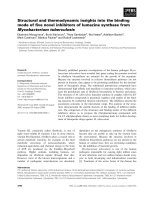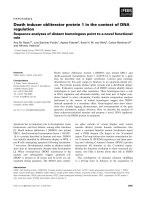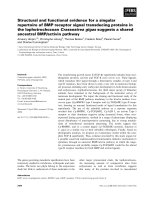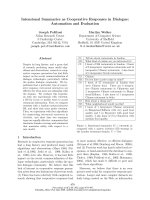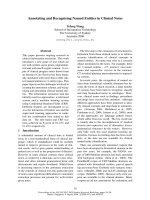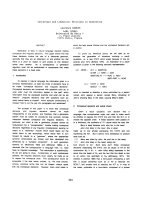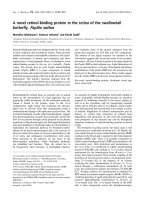báo cáo khoa học: "Prenatal and postnatal correlated responses in maternal traits of mice assessed by crossfostering" ppsx
Bạn đang xem bản rút gọn của tài liệu. Xem và tải ngay bản đầy đủ của tài liệu tại đây (662.1 KB, 12 trang )
Prenatal
and
postnatal
correlated
responses
in
maternal
traits
of
mice
assessed
by
crossfostering
E.J. EISEN
T.R.
BANDY
Department
of
Animal
Science,
North
Carolina
State
University
Box
7621,
Raleigh,
NC
27695-7621,
U.S.A.
Summary
A
crossfostering
design
was
used
to
estimate
correlated
responses
in
prenatal
genetic
and
postnatal
maternal
effects
for
maternal
traits
of
mice
(female
body
weights
at
mating,
at
parturition
and
at
12-d
postpartum,
litter
size
and
weight
at
birth,
percent
born
alive,
standardized
(12
pups)
12-d
litter
weight
and
birth
to
12-d
litter
feed
efficiency
=
litter
weight
gain/dam
feed
intake).
Lines
of
mice
had
been
selected
as
follows :
large
first-parity
litter
size
at
birth
(L+) ;
large
6-wk
body
weight
(W+) ;
an
index
for
large
litter
size
and
small
6-wk
body
weight
(L+W-)
and
randomly
(K).
Prenatal
line
refers
to
the
line
into
which
a
female
was
born,
and
postnatal
line
is
that
of
the
foster
mother
that
nursed
the
female.
Crossfostering
sets
were
formed
at
birth
with
equal
numbers
of
pups
from
the
4
lines
reared
either
in
litters
of
8
or
16.
Dams
reared
in
litters
of
8
were
heavier,
had
larger
litters
at
birth
and
larger
litter
weights
at
birth
and
12-d
postpartum
(P
<
0.05).
No
biologically
important
interactions
were
found
between
number
reared
and
prenatal
genetic
effects
or
between
number
reared
and
postnatal
maternal
effects.
Selection for
litter
size
at
birth
and
(or)
6-wk
body
weight
resulted
in
large
correlated
responses
in
maternal
traits.
Correlated
responses
in
postnatal
maternal
effects
were
relatively
small
compared
with
prenatal
genetic
effects.
Prenatal
genetic
by
postnatal
maternal
interactions
generally
were
not
of
biological
importance.
Postnatal
maternal
effects
contributed
much
less
to
correlated
responses
in
traits
associated
with
reproduction
and
maternal
performance
compared
with
growth-related
traits.
Key
words :
Correlated
responses,
maternal
effects,
reproductive
trnits,
mice.
Résumé
Réponses
corrélées
pré-
et
post-natales
sur
des
caractères
maternels
de
la
souris
évaluées
par
un
dispositif
d’allaitement
croisé
Un
dispositif
d’allaitement
croisé
a
été
utilisé
pour
estimer
les
réponses
corrélées
sur
les
effets
génétiques
prénataux
et
les
effets
maternels
postnataux
pour
des
caractères
d’aptitude
maternelle
chez
la
souris
(poids
corporel
de
la
femelle
lors
de
l’accouplement,
(1)
Paper
No.
9963
of
the
Journal
Series
of
the
North
Carolina
Agricultural
Research
Service,
Raleigh
27695.
The
use
of
trade
names
in
this
publication
does
not
imply
endorsement
by
the
North
Carolina
Agricultural
Research
Service
of
the
products
named,
nor
criticism
of
similar
ones
not
mentioned.
(2)
Present
address :
Department
of
Animal
Science,
Purdue
University,
Lafayette,
IN
47907.
à
la
parturition
et
12
jours
post
partum,
taille
et
poids
de
la
portée
à
la
naissance,
pourcentage
de
nés
vivants,
poids
de
portée
à
12
jours
standardisé
(à
12
produits)
et
efficacité
alimentaire
de
0
à
12
jours
définie
comme
le
rapport
du
gain
de
poids
de
la
portée
à
la
consommation
de
la
mère).
Les
lignées
de
souris
utilisées
ont
été
sélectionnées
de
la
manière
suivante :
sélection
pour
une
taille
de
portée
élevée
à
la
naissance
en
parité
1
(L+) ;
sélection
pour
le
poids
corporel
à
6
semaines
(W+) ;
sélection
sur
un
index
pour
une
taille
de
portée
élevée
et
un
faible
poids
corporel
à
6
semaines
(L+W-)
et
lignée
témoin
(K).
Le
terme
de
« lignée
prénatale
» désigne
la
lignée
dans
laquelle
une
femelle
est
née,
celui
de
« lignée
postnatale
» la
lignée
de
la
mère
adoptive
qui
allaite
la
femelle.
Des
groupes
d’allaitement
croisé
ont
été
constitués
à
la
naissance
avec
des
nombres
égaux
de
souriceaux
issus
des
4
lignées,
élevés
en
portée
de
8
ou
de
16.
Les
mères
élevées
en
portées
de
8
sont
plus
lourdes ;
les
portées
qu’elles
produisent
ont
une
taille
plus
élevée
à
la
naissance,
ainsi
que
des
poids
plus
importants
à
la
naissance
et
12
jours
post
partum
(P
<
0,05).
On
n’a
pas
trouvé
d’interactions
biologiquement
importantes
entre
la
taille
de
portée
d’origine
et
les
effets
génétiques
prénataux,
ni
entre
la
taille
de
portée
d’origine
et
les
effets
maternels
postnataux.
La
sélection
pour
la
taille
de
portée
à
la
naissance
et
(ou)
le
poids
corporel
à
6
semaines
entraîne
d’importantes
réponses
corrélées
sur
les
caractères
maternels.
Les
réponses
corrélées
sur
les
effets
maternels
postnataux
sont
relativement
faibles
comparées
à
celles
observées
sur
les
effets
génétiques
prénataux.
Les
interactions
entre
les
effets
génétiques
prénataux
et
les
effets
maternels
postnataux
ne
sont
en
général
pas
biologiquement
importantes.
Les
effets
maternels
postnataux
contribuent
beaucoup
moins
aux
réponses
corrélées
sur
les
caractères
associés
à
la
reproduction
et
aux
aptitudes
mater-
nelles
qu’à
celles
observées
sur
les
caractères
liés
à
la
croissance.
Mots
clés :
Réponses
corrélées,
effets
maternels,
caractères
de
reproduction,
souris.
I.
Introduction
Selection
for
increased
reproductive
performance
has
received
considerable
em-
phasis
in
pigs
(C
UNNINGHAM
et
C
ll.,
1979 ;
B
ICHARD
&
S
EIDEL
,
1982 ;
B
OLET
&
L
EGAULT
,
1982),
beef
cattle
(PIPER
&
B
INDON
,
1979 ;
1VI
ORRIS
,
1984),
sheep
(H
ANRAHAN
,
1982)
and
rabbits
(M
ATHERON
,
1982).
Selection
response
depends
upon
variances
of
both
direct
and
maternal
breeding
values
and
the
covariance
between
them
(VAN
V
LECK
,
1970,
1973 ;
H
ANRAHAN
,
1976).
Information
on
additive
maternal
genetic
variance
for
reproductive
traits
and
genetic
correlations
between
maternal
and
direct
genetic
effects
generally
is
lacking
in
livestock.
Consequently,
the
expected
correlated
responses
in
maternal
effects
from
selection
for
reproductive
traits
and
indices
that
include
reproductive
traits
are
usually
unknown.
In
this
study
the
mouse
was
used
in
a
crossfostering
design
to
estimate
correlated
responses
in
postnatal
maternal
and
prenatal
genetic
effects
on
maternal
traits
in
lines
that
had
been
selected
for
litter
size
and
(or)
body
weight.
Dams
were
reared
in
small
(8)
or
large
(16)
litters
to
determine
if
litter
size
in
which
a
dam
was
reared
interacted
with
maternal
and
(or)
prenatal
genetic
effects.
In
a
previous
paper,
corre-
lated
responses
were
reported
for
progeny
growth
from
the
same
crossfostering
experi-
ment
(BANDY
&
E
ISEN
,
1984).
II.
Materials
and
methods
Lines
used
in
this
study
had
been
selected
as
follows
(E
ISEN
,
1978) :
large
first-parity
litter
size
at
birth
(L
+
) ;
large
6-wk
body
weight
(W
+
) ;
an
index
for
large
litter
size
and
small
6-wk
body
weight
(L+W-)
and
randomly
(K).
Selection
had
been
practiced
contemporaneously
in
each
line
for
23
generations
and
was
followed
by
10
generations
of
relaxed
selection.
No
evidence
of
genetic
slippage
or
inbreeding
depression
has
been
observed
(H
ORSTGEN
-S
CHWARK
et
al.,
1984).
The
design
of the
crossfostering
experiment
was
given
previously
(BANDY
&
E
ISEN
,
1984).
Briefly,
virgin
males
and
females
from
generation
33
were
randomly
paired
within
lines.
Beginning
on
day
19
after
mating,
females
were
checked
daily
at
0700
and
1500
h
for
littering.
Crossfostering
sets
were
formed
by
choosing
4
dams
at
random,
one
from
each
line,
having
littered
within
the
same
or
adjacent
periods.
Sets
were
allocated
alternately
to
litter
standardization
of
8
(LS8)
or
16
(LS16)
for
a
total
of
40
sets
for
each
litter
size
group.
Crossfostering
was
accomplished
by
randomly
assigning
either
one
(in
LS8)
or
2
(in
LS16)
pups
of
each
sex
from
each
of
the
4
litters
to
each
of
the
dams
in
the
set.
The
crossfostering
design
provides
estimates
of
a
prenatal
line
effect
(a
;)
and
a
postnatal
line
effect
(p
;
).
Prenatal
line
refers
to
the
line
into
which
an
individual
female
was
born,
and
postnatal
line
is
the
line
of
the
dam
that
nursed
the
female.
The
present
crossfostering
design
gave
rise
to
32
prenatal
line
by
postnatal
line
by
number
reared
subclasses.
Because
of
space
limitations,
half
of
the
females
within
each
subclass
were
assigned
randomly
to
be
mated
at
either
9
or
12
weeks
of
age.
Mating
pairs
were
randomly
formed
within
each
subclass.
After
16
days
of
continuous
cohabitation
with
a
male,
females
were
caged
singly
and
subsequently
checked
twice
daily
for
litters.
The
goal
was
to
standardize
litters
to
12
pups
on
the
day
of
birth,
attempting
to
get,
as
nearly
as
possible,
an
equal
sex
ratio.
Fostered
individuals
were
used
only
within
the
same
prenatal
line
by
postnatal
line
by
number
reared
subclass.
Standar-
dization
to
12
pups
was
achieved
in
approximately
85
p.
100
of
the
1050
litters.
The
following
traits
were
measured :
dam
body
weights
at
mating,
at
parturition
and
at
12-days
postpartum ;
litter
size
born ;
percentage
born
alive ;
achieved
number
of
pups
standardized
and
number
at
12
days
postpartum ;
litter
weight
at
birth
before
and
after
standardization,
and
at
12
days
postpartum ;
dam
feed
intake
from
birth
to
12-days
postpartum ;
and
litter
feed
efficiency
defined
as
100
X
litter
weight
gain/dam
feed
intake
in
the
interval
from
birth
to
12
days
postpartum.
Litter
feed
efficiency
is
a
justified
measurement
because
the
pups’
only
source
of
nutrients
during
this
interval
is
the
dam’s
milk.
Dams
had
been
fed
ad
libitum
Purina
Laboratory
Chow
from
weaning
until
they
were
mated,
at
which
time
Purina
Mouse
Chow
was
fed
ad
libitum.
The
laboratory
was
maintained
at
22
-!
2
C
and
60
::!::
10
p.
100
relative
humidity
with
a
12-h
light :
12-h
dark
cycle.
The
least-squares
analysis
for
unbalanced
data
was
based
on
a
statistical
model
that
included
the
effects
of
age
of
dam,
litter
size
in
which
the
dam
had
been
reared,
crossfostering
sets
within
litter
size
reared,
prenatal
line
of
dam,
postnatal
line
of
dam,
interactions,
experimental
error
and
residual.
All
effects
were
assumed
fixed
except
for
sets,
experimental
error
and
residual
effects
which
were
assumed
random.
Litter
size
in
which
a
dam
was
reared
was
tested
by
sets.
All
other
fixed
effects
were
tested
with
the
experimental
error,
which
was
obtained
by
pooling
all
interactions
involving
sets.
Interactions
between
fixed
effects
generally
were
not
important.
Cova-
riates
added
to
the
model
for
some
traits
will
be
discussed
in
results.
III.
Results
A.
Age
of
dam
Least-squares
means
for
mating
age
of
dams
are
given
in
table
1.
Older
dams
were
about
9
p.
100
larger
(P
<
0.05)
at
mating.
The
age
difference
in
dam
body
weight
was
significant
at
parturition,
but
was
not
large
enough
to
be
considered
of
bio-
logical
importance.
No
dam
body
weight
difference
was
found
at
12-days
postpartum.
Number
born
was
about
4
p.
100
larger
(P
<
0.05)
in
alder
dams.
The
difference
was
significant
(P
<
0.05)
even
after
covariance
adjustment
for
dam
body
weight
at
parturition
(9
wk
=
14.1
vs
12
wk
=
14.5).
Age
of
dam
did
not
affect
percentage
born
alive,
litter
weight
at
birth
and
at
12
days,
or
litter
feed
efficiency.
B.
Litter
size
in
which
a
dam
was
reared
Dams
reared
in
LS8
were
larger
(P
<
0.05)
at
mating
(10.3
p.
100),
parturition
(7.1
p.
100)
and
12-days
postpartum
(7.1
p.
100)
than
dams
reared
in
LS16
(tabl.
2).
Dams
reared
in
the
smaller
litter
size
also
had
8.0
p.
100
larger
(P
<
0.05)
litters
at
birth
and
5.6
p.
100
larger
litter
weights
at
birth
and
2.4
p.
100
larger
litter
weights
at
12-days
postpartum.
When
number
alive
at
12
days
was
used
as
a
covariate,
the
litter
weight
difference
at
12
days
was
still
significant
(P
<
0.05).
The
effect
of
litter
size
in
which
a
dam
was
reared
did
not
significantly
influence
litter
size
born
when
adjusted
for
dam
parturition
body
weight
(LS8
=
14.4
vs
LS16
=
14.1).
Per-
centage
born
alive
and
litter
feed
efficiency
were
not
affected
by
the
litter
size
in
which
a
dam
was
reared.
C.
Prenatal
genetic
(a
i)
and
postnatal
maternal
genetic
(p!)
effects
Prenatal
line
effects
were
more
important
than
postnatal
line
effects
for
dam
body
weights
(tabi.
3).
Prenatal
line
differences
for
dam
body
weight
at
mating
were
similar
to
prenatal
line
differences
for
6-wk
body
weight
(BANDY
&
E
ISEN
,
1984).
The
correlated
responses
in
prenatal
line
effects
for
dam
body
weight
were
main-
tained
at
parturition
and
12-days
postpartum
in
L+
and
W+,
but
L+
W-
showed
no
significant
correlated
responses
at
these
stages
of
reproduction.
Correlated
responses
in
postnatal
line
effects
for
dam
body
weight
at
joining
were
positive
(P
<
0.05)
for
W+
and
negative
(P
<
0.05)
for
L+
W-,
but
only
in
L+
W-
was
the
correlated
res-
ponse
maintained
for
dam
body
weights
at
parturition
and
12-days
postpartum.
Correlated
responses
in
prenatal
genetic
and
postnatal
maternal
effects
for
each
selected
line
are
graphed
for
the
reproductive
and
postpartum
traits
as
deviations
from
the
control
line
and
pooled
across
dam
age
and
litter
size
in
which
a
dam
was
reared
(fig.
1
AE).
The
pooling
was
justified
because
interactions
were
negligible.
Positive
correlated
responses
in
al
for
litter
size
born
and
litter
birth
weight
were
found
for
L+,
W+
and
L+W-,
whereas
negative
correlated
responses
were
observed
for
percent
born
alive.
For
12-day
litter
weight,
ai
increased
in
L+
and
W+,
but
decreased
in
L+W
Correlated
responses
in
al
for
litter
feed
efficiency
were
positive
in
L+
and
negative
in
L+W
Lines
L+
and
W+
had
no
significant
correlated
responses
in
pi
for
any
of
the
reproductive
traits.
Litter
size
born
and
12-day
litter
weight
in
L+
W-
were
the
only
significant
(negative)
correlated
responses
in
pi.
The
correlated
response
in
12-day
litter
weight
was
not
affected
by
the
covariance
adjustment
for
number
at
12
days.
Standardized
measures
of
the
among-line
variation
in
prenatal
genetic
and
postnatal
maternal
effects
can
be
used
to
assess
their
relative
importance.
The
effects
of
within-line
variation
on
a
mean
basis
were
assumed
negligible
because
of
large
within-line
sample
size.
The
relative
among-line
variation
in
estimates
of
a;
and
pi
for
each
trait
was
defined
as :
and
line
prenatal
genetic
and
postnatal
maternal
variances,
X!;
is
the
control
line
mean
and
n
is
the
number
of
lines.
The
ratio
<Pal <Pp
represents
an
estimate
of
the
relative
importance
of
prenatal
genetic
compared
with
postnatal
maternal
among-line
varia-
tion.
Results
of
this
analysis
are
given
in
table
4.
Estimates
of
cp
a
were
considerably
larger
than
(Dp
for
all
maternal
traits.
Negative
correlations
between
prenatal
genetic
and
postnatal
maternal
effects
can
affect
the
choice
of
breeds
for
a
breeding
system.
The
present
data
were
used
to
calculate
the
correlation
between
the
among-line
prenatal
genetic
and
postnatal
maternal
genetic
effects,
defined
as :
Although
the
number
of
lines
was
not
large
enough
to
provide
a
precise
estimate
of
ra
p,
the
data
do
provide
a
general
picture
of
the
degree
of
possible
antagonisms.
Within
this
set
of
selection
criteria
there
was
no
evidence
of
any
serious
antagonisms
for
traits
of
the
dam
(tabl.
4).
IV.
Discussion
Expected
direct
response
to
individual
selection
depends
upon
direct
and
maternal
heritabilities
and
the
genetic
correlation
between
direct
and
maternal
effects.
For
correlated
responses,
this
expectation
depends
upon
the
genetic
correlations
between
direct
effects,
between
maternal
effects
and
between
direct
and
maternal
effects
for
the
selected
and
unselected
traits.
Often,
the
entire
suite
of
genetic
parameters
are
not
known
well
enough
to
make
accurate
predictions.
Therefore,
as
a
first
approximation,
the
maternal
parameters
usually
are
ignored
in
determining
predicted
direct
and
correlated
responses
to
selection.
The
present
study
used
the
crossfostering
design
to
examine
the
importance
of
postnatal
maternal
correlated
responses
in
retrospect ;
i.e,
after
the
selection
experiment
was
completed.
Lines
of
mice
had
been
selected
for
growth
(large
6-wk
body
weight),
reproduction
(large
litter
size)
and
an
index
(large
litter
size
and
small
body
weight)
antagonistic
to
the
positive
genetic
correlation
(r
G
= .5)
between
litter
size
and
adult
body
weight
(E
ISEN
,
1978).
Selection
for
litter
size
at
birth
and
(or)
6-wk
body
weight
resulted
in
large
corre-
lated
responses
in
reproductive
and
maternal
traits.
Correlated
responses
in
postnatal
maternal
genetic
effects
were
relatively
small
compared
with
prenatal
genetic
effects.
This
contrasts
with
individual
growth
traits
through
weaning,
estimated
from
the
same
crossfostering
study
(BANDY
&
E
ISEN
,
1984).
For
example,
among-line
variation
was
approximately
equal
for
postnatal
maternal
genetic
and
prenatal
genetic
effects
on
weaning
weight
of
progeny
reared
in
litters
of
8,
and
postnatal
maternal
genetic
variation
was
2.76
times
greater
than
prenatal
genetic
effects
in
progeny
reared
in
litters
of
16.
Prenatal
genetic
effects
were
more
important
than
postnatal
maternal
genetic
effects
for
6-wk
body
weight
(BANDY
&
EcsErr,
1984),
but
the
ratio
of
!8/!P
was
smaller
than
for
dam
body
weights
at
mating,
parturition
and
12-days
postpartum.
The
conclusion
from
this
study
and
others
using
these
lines
(BANDY
&
EtsErr,
1984 ;
EcsErr
et
al.,
1984 ;
H
ORSTGEN
-S
CHWARK
et
al.,
1984)
is
that
postnatal
maternal
effects
are
much
less
important
in
determining
correlated
responses
in
traits
associated
with
reproduction
and
maternal
performance
compared
with
growth-related
traits.
WHITE
et
al.
(1968)
used
the
same
crossfostering
design
to
study
correlated
res-
ponses
in
traits
of
the
dam
in
lines
selected
for
large
and
small
6-wk
body
weight.
In
agreement
with
the
present
study,
prenatal
genetic
effects
were
more
important
than
postnatal
maternal
effects.
Selection
for
large
6-wk
body
weight
resulted
in
a
significant
positive
correlated
response
in
prenatal
genetic
effects
on
litter
size
although
the
effect
was
much
smaller
than
that
observed
in
the
present
study.
In
contrast
with
the
present
study,
12-day
litter
weight
showed
a
negative
correlated
response
for
prenatal
effects
in
a
line
selected
for
large
6-wk
body
weight.
The
absence
of
large
negative
correlations
between
prenatal
genetic
and
post-
natal
maternal
effects
for
dam
traits
suggests
that
in
selection
among
these
lines
or
lines
having
a
similar
history
of
selection,
antagonisms
between
prenatal
genetic
and
postnatal
maternal
effects
would
not
be
expected
for
maternal
traits.
These
correlations
are
a
function
of
the
selection
criteria
applied
to
the
lines
and
cannot
be
extrapolated
to
other
sets
of
lines.
There
were
no
biologically
important
interactions
of
prenatal
genetic
by
post-
natal
maternal,
prenatal
genetic
by
number
reared,
postnatal
maternal
by
number
reared
or
prenatal
genetic
by
postnatal
maternal
by
number
reared
effects.
Interactions
that
were
significant
generally
were
the
result
of
a
change
in
magnitude
of
mean
differences
rather
than
a
change
in
ranking
of
means.
Similar
results
were
observed
for
growth
traits
of
the
progeny
(BANDY
&
E
ISEN
,
1984).
Absence
of
prenatal
line
by
postnatal
line
interactions
indicates
that
fostering
effects
per
se
were
relatively
unim-
portant.
Lack
of
significant
prenatal
line
by
number
reared
and
postnatal
line
by
number
reared
interactions
suggests
that
correlated
responses
in
reproductive
and
maternal
traits
were
nominally
affected
by
the
size
of
the
litter
in
which
the
dam
was
reared.
In
general,
the
estimated
correlated
responses
for
prenatal
and
postnatal
ma-
ternal
genetic
effects
were
in
agreement
with
estimates
from
a
diallel
design
using
the
same
lines
(E
ISEN
et
al.,
1984 ;
H
ORSTGEN
-S
CHWARK
Bt
al.,
1984).
There
were,
however,
some
specific
differences
in
correlated
responses
for
the
corresponding
estimates
in
the
diallel
design
(p
i
vs
mi)
and
the
crossfostering
design
(a
i
vs
Qi)
(ErsErr
et
al.,
1985),
where
pi
and
ai
are
as
defined
previously,
and
mi
and
52;
are
the
average
line
maternal
and
line
direct
genetic
effects
as
defined
in
the
diallel
design
(E
ISEN
et
al.,
1984).
Part
of
the
reason
for
the
observed
differences
could
be
caused
by
differences
in
biological
expectation
of
the
estimates
from
each
design
(BANDY
&
E
ISEN
,
1984).
Assuming
a
model
with
no
paternal
effects
and
no
interactions
among
effects,
the
maternal
and
direct
genetic
effects
for
line
i
in
a
diallel
design
have
expectations
and
whereas
the
postnatal
maternal
genetic
and
prenatal
effects
in
a
crossfostering
design
have
expectations
and
where
E
is
the
expected
value
operator,
Mi
=
average
postnatal
(lactational
and/or
behavioral)
maternal
genetic
effects,
Ui
=
average
prenatal
(intrauterine)
maternal
genetic
effects,
Ci
=
average
cytoplasmic
and
(or)
pathogen
or
antibody
transmitted
maternal
effects
and
A;
=
average
direct
genetic
effects.
From
the
above
expectations,
it
is
possible
to
obtain
only
2
confounded
estimates
of
uterine
and
cytoplasmic
effects
While
it
is
tempting
to
use
the
present
data
to
estimate
U;
+
C;,
it is
inappropriate
because
the
2
designs
were
confounded
with
time
effects
and
the
number
of
gene-
rations
of
relaxed
selection.
Also,
dams
were
reared
in
litters
of
eight
in
the
diallel
design
while
dams
in
the
crossfostering
design
were
reared
in
litters
of
8
or
16.
For
postpartum
performance
traits,
litters
were
not
standardized
in
the
diallel
design,
but
were
in
the
crossfostering
design.
Uterine
maternal
effects
on
growth
have
not
been
detected
in
mice
beyond
2
weeks
of
age,
and
even
at
2
weeks
uterine
effects
are
not
as
large
as
postnatal
maternal
or
direct
genetic
effects
(MooxE et
al.,
1970 ;
AL
-M
URRANI
&
R
OBERTS
,
1978).
The
role
that
cytoplasmic
maternal
effects
has
on
quantitative
traits
in
animals
is
just
beginning
to
be
investigated.
BELL
et
al.
(1985)
reported
cytoplasmic
effects
for
first
lactation
milk
yield,
milk
fat
yield,
fat-corrected
milk
yield
and
milk
fat
percentage
in
dairy
cattle.
Because
mitochondria
play
a key
role
in
electron
transport
and
oxidative
phosphorylation,
they
are
a
prime
candidate
for
cytoplasmic
maternal
effects
contri-
buting
to
selection
response.
Maternal
effects
associated
with
selection
of
maternally
transmitted
antibodies
or
pathogens
may
also
affect
selection
responses.
M
AYER
et
al.
(1980)
found
maternal
transmission
of
resistance
to
lymphoma
development
in
reciprocal
crosses
of
2
strains
of
mice.
HARRIS
(1982)
has
shown
that
a
congenitally
transmitted
virus
from
dam
to
offspring
can
modify
selection
response
in
poultry.
Further
studies
are
needed
to
determine
the
importance
of
cytoplasmically
trans-
mitted
maternal
effects
on
metric
traits.
Received
June
26,
1985.
Accepted
December
10,
1985.
References
AL
-M
URRANI
W.K.,
R
OBERTS
R.C.,
1978.
Maternal
effects
on
body
weight
in
mice
selected
for
large
and
small
size.
Genet.
Res.,
’32,
295-302.
BANDY
T.R.,
E
ISEN
E.J.,
1984.
Prenatal
and
postnatal
effects
in
mouse
lines
selected
for
body
weight
and
litter
size :
Performance
of
postnatal
dams
and
growth
of
progeny.
J.
Anim.
Sci.,
59,
896-907.
BELL
B.R.,
McD
A
NIEL
B.T.,
R
OBISON
O.W.,
1985.
Effects
of
cytoplasmic
inheritance
on
production
traits
in
dairy
cattle.
J.
Dairy
Sci.,
68,
2038-2051.
B
ICHARD
M.,
S
EIDEL
C.M.,
1982.
Selection
for
reproductive
performance
in
maternal
lines
of
pigs.
Second
World
Congress
on
Genetics
Applied
to
Livestock
Production,
Vol.
VIII,
565-569,
Editorial
Garsi,
Madrid.
B
OLET
G.,
L
EGAULT
C.,
1982.
New
aspects
of
genetic
improvement
of
prolificacy
in
pigs.
Second
World
Congress
on
Genetics
Applied
to
Livestock
Production,
Vol.
V,
548-567,
Editorial
Garsi,
Madrid.
C
UNNINGHAM
P.J.,
ENGLAND
M.E.,
YOUNG
L.D.,
Z
IMMERMAN
D.R.,
1979.
Selection
for
ovulation
rate
in
swine :
Correlated
response
in
litter
size
and
weight.
J.
Anim.
Sci.,
48,
509-516.
E
ISEN
E.J.,
1978.
Single-trait
and
antagonistic
index
selection
for
litter
size
and
body
weight
in
mice.
Genetics,
88,
781-811.
E
ISEN
E.J.,
H
ORSTGEN
-S
CHWARK
G.,
BANDY
T.R.,
S
AXTON
A.M.,
1984.
Postpartum
per-
formance
in
a
diallel
cross
among
lines
of
mice
selected
for
litter
size
and
body
weight.
J. Anim.
Sci.,
58,
863-877.
E
ISEN
E.J.,
BANDY
T.R.,
H
ORSTGEN
-S
CHWARK
G.,
S
AXT
ON
A.M.,
1985.
Correlated
responses
in
maternal
effects
caused
by
single
trait
or
antagonistic
index
selection
for
litter
size
and
body
weight
in
mice.
Proc.
34th
Annual
National
Breeders’
Roundtable.
Poultry
Breeders
of
America,
31-63,
St.
Louis,
MO.
H
ANRAHAN
J.P.,
1976.
Maternal
effects
and
selection
response
with
an
application
to
sheep
data.
Anim.
Prod.,
22,
359-369.
H
ANRAHAN
J.P.,
1982.
Selection
for
increased
ovulation
rate,
litter
size
and
embryo
survival.
Second
World
Congress
on
Genetics
Applied
to
Livestock
Production,
Vol.
V,
294-309,
Editorial
Garsi,
Madrid.
HARRIS
D.L.,
1982.
Congenitally
transmitted
pathogens
and
their
consequences
in
animal
and
poultry
breeding.
Second
World
Congress
on
Genetics
Applied
to
Livestock
Production,
Vol.
V,
175-185,
Editorial
Garsi,
Madrid.
H
ORSTGEN
-S
CHWA
R.
K
G.,
E
ISEN
E.J.,
S
AXTON
A.M.,
BANDY
T.R.,
1984.
Reproductive
performance
in
a
diallel
cross
among
lines
of
mice
selected
for
litter
size
and
body
weight.
J.
Anim.
Sci.,
58,
846-862.
M
AT
H
ERON
G.,
1982.
Genetics
and
selection
of
litter
size in
rabbit.
Second
World
Congress
on
Genetics
Applied
to
Livestock
Production,
Vol.
VI,
481-498,
Editorial
Garsi,
Madrid.
M
AYER
A.,
S
TRUUCK
F.D.,
D
URAN
-R
EYNALS
M.L.,
L
ILLY
F.,
1980.
Maternally
transmitted
resistance
to
lymphoma
development
in
mice
of
reciprocal
crosses
of
the
RF/J
and
AKR/J
strains.
Cell,
19,
431-436.
M
OORE
R.W.,
E
ISEN
E.J.,
U
LBERG
L.C.,
1970.
Prenatal
and
postnatal
maternal
influence
on
growth
in
mice
selected
for
body
weight.
Genetics,
64,
59-68.
MORRIS
C.A.,
1984.
A
Review
of
the
genetics
and
reproductive
physiology
of
dizygotic
twinning
in
cattle.
Anim.
Br.
Abstr.,
52,
803-819.
PIPER
L.R.,
B
INDON
B.M.,
1979.
Selection
for
increased
cow
fecundity :
A
review
Proc.
New
Zealand
Soc.
Anim.
Prod.,
39,
224-232.
V
AN
V
LEC
TC
L.D.,
1970.
Index
selection
for
direct
and
maternal
genetic
components
of
economic
traits.
Biometrics,
26,
477-483.
V
AN
V
LECK
L.D.,
1973.
Selection
for
direct
and
maternal
genetic
effects.
In
B
OGART
R.
(ed.),
Genetics
Lectures,
133-148,
Oregon
State
Univ.
Press,
Corvallis.
WHITE
J.M.,
LEGATES
J.E.,
E
ISEN
E.J.,
1968.
Maternal
effects
among
lines
of
mice
selected
for
body
weight.
Genetics,
60,
395-408.
